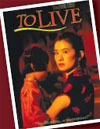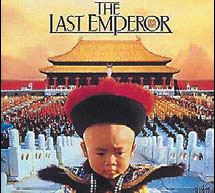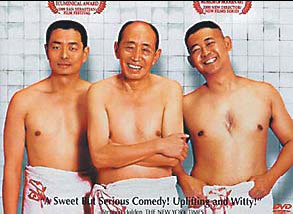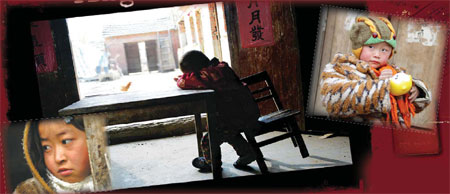Movies you cannot miss
|
Oscar-winning documentary Blood of Yingzhou District is about AIDS orphans. File photos |
So, you have enrolled in language lessons and sworn you will master Putonghua for that authentic China experience (Sigh! Easier said than done). You have booked a spot on any and every culture trip that promises to take you off the beaten track to see the "real" China and you have scoured every downtown area for a genuine, untouched hutong "to see how locals really lived". (But where, oh where, are these gems ?)

Now, how about catching "the films you must see before you leave China"? Here they are, all of them award-winners, this list inspired by a lecture given on this very topic by movie aficionado Breen O'Reilly, who teaches Film Studies at the International School of Beijing.
To Live (1994)
If you're able to watch only one film about China, make it this one. "This is all you need to see to know the history of China in the past 50 years," says O'Reilly. He adds that when the movie was shown to a mixed audience of Chinese and Westerners, it was interesting to see how the Chinese immediately saw how the title tied in with the ending while the rest were less convinced.

The Last Emperor (1987)
This epic film won nine Oscars and tells the story of the last emperor of the Qing Dynasty (1644-1911), Pu Yi. The highlights are the film's use of colors and its music - ironically, the Western music was scored by an Asian, Ryuichi Sakamoto, while the Asian score was by the American David Byrne, of the band Talking Heads.
Bertolucci seems to have worked with a color palette, says O'Reilly, drawing attention to the scene in which Pu Yi is arrested and is to be banished to Manchuria. He slashes his wrists while at the railway station and as the camera zooms in on the red blood, the flashback moves to the red gates of the palace of his childhood.
Reds, yellows and oranges, all colors of warmth and happiness, dominate the screen for the part of the story that deals with his royal life. The colors shift to green and blue, when his English tutor (Peter O'Toole) arrives on his green cycle, and the emperor himself is seen in blue glasses, to signify the narrative's shift of focus.

Shower (1999)
This film by Zhang Yang tells the story of a Shenzhen businessman who returns home to Beijing thinking his father - who runs a bathhouse - has died. It turns out, however, to just be a ruse used by his mentally retarded brother to get him home. Given his father's failing health, the central character has to take stock of his family and future.
O'Reilly calls this his favorite film, pointing to the humor generated by its many sub-plots centered on the bathhouse patrons.
The director makes good use of cinematic space to show the two separate worlds of the sophisticated Shenzhenite and the more rough-cut father and son and as the movie progresses, uses it to convey how those worlds move closer.
Blood of Yingzhou District (2006)
This Oscar-winning documentary is about an AIDS orphan and the moving nature of the subject is reinforced by the cinematic techniques. The camera is kept at the boy's eye level and shows, says O'Reilly, the world from his perspective. The boy is also often framed in the doorway, with the camera inside, as though to show him reaching out to the outside world.
Blind Shaft (2003)
This bleak, almost Hitchcock-style film tells the story of two Chinese coal miners who hit upon the perfect scam: luring an unsuspecting job seeker to the mines, murdering him and extorting money from the boss as compensation for their "relative".
The film's setting is the black landscape of a coal mine and the blue and gray overtones reinforce its dark theme. One interesting detail, says O'Reilly, is what the duo do with all the bundles of money they collect. A movie sure to stir the conscience.
Up the Yangtze (2007)
Made by a Canadian-Chinese, Yung Chang, this is a great snapshot of a certain period of history from two different perspectives. The main character is a girl whose house is about to be submerged by the construction of the dam; the other protagonist is a product of the one-child policy, a self-centered man who just wants to get rich. Both get a job on one of the boats that ply the Yangtze.
Mardi Gras; Made in China (2005)
The film offers a wonderful insight into globalization by following the journey of a bead. It is made by the world's largest producer of beads and other Mardi Gras trinkets at a disciplined factory in Fuzhou and used by revelers in the New Orleans Mardi Gras, where the beads offer a peek at a naked breast.
The film juxtaposes candid comments from the Chinese boss of the bead factory and the American buyer at the other end. It also captures the Chinese workers' reactions when they are shown where the product of their hard work ends up, making for an interesting comment on capitalism and globalization.
Blind Mountain (2007)
Another searing look at society, this film tells the story of girls who are lured into jobs but are actually sold. The main protagonist, a college graduate, thinks she is going to be working for a pharmacy but is forced to play wife to an illiterate man in a remote mountain region. It is unrelentingly bleak to the very end and the handheld camera gives it a shaky, edgy feel.
Manufactured Landscapes (2006)
In this documentary, director Jennifer Baichwal follows the work of renowned Canadian artist Edward Burtynsky, known for his large-scale photographs of "manufactured landscapes" - recycling yards, factories, dams - and follows him through China as he details the effects of its massive industrialization. It looks at the centers of this industrial effort and their dumping grounds.
The above list is definitely not exhaustive, says O'Reilly. As if to prove the point, he says he would have loved to include The Road Home (a 1999 film by Zhang Yimou, set in the turbulent times of the "cultural revolution"); Not One Less, again by Zhang Yimou (about education in China); and All the Invisible Children, a 2005 collection of seven short films on childhood and exploitation.
Room might also have been found for Song Song and Little Cat, by John Woo, a director better known for his blockbusters. With a simple plot of a young abandoned girl and an old man, the film manages to pack a punch of raw emotion and social comment into just 20 minutes, leaving a powerful impact on the viewer.
(China Daily 04/20/2009 page10)















